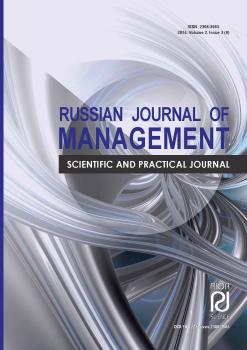Situational analysis allows to combine ideas about marketing and management areas, at least at the strategic level, to look at regional development from the standpoint of Strategic Market Management. Especially great is its role in building the vision of the future territorial formation and selection of the main areas to achieve it. Actually, Strategic Market Management territorial development, based on the strategic positioning of the city or region combines three aspects of accounting and management: a category that successfully meets the needs of their environment (it is), the consumer segment (for whom it is) and benefits (it gives the consumer), — and is intended to reconcile the promises that gives elected in the strategic positioning of the brand of the city or region, with the actual investment strategy, which should provide a parallel implementation of the identified competitive advantages of the region or city through the implementation of strategic initiatives and project — specific drivers that are actively interested in the main consumers of media city or region — residents, businesses, investors. The results of such initiatives and projects, in turn, provide the efficiency and quality of reproduction and use of strategic resources of cities and regions, the best implementation of the three main functions as a place of residence, place of management and recreational facilities, and thus increase the competitiveness of the territorial entities and improve their strategic positioning.
strategic positioning, situation, region, city, territorial development, strategic marketing, strategic management, monitoring.
В настоящее время разрабатывается проект федерального закона о стратегическом планировании. Как показывают идущие вокруг него дискуссии, в том числе на XII Общероссийском форуме стратегического планирования в регионах и городах России, который состоится 21–22 октября 2013 г. в Санкт-Петербурге, в сфере стратегического менеджмента территориального развития в нашей стране в настоящее время одновременно активно разрабатывается различными государственными ведомствами и реализуется целый ряд документов, слабо согласованных между собой и имеющими различный административно-правовой статус. Речь идет о стратегиях социально-экономического развития и их аспектно-отраслевых версиях, например инвестиционных, о генеральных планах развития городов, генеральных схемах развития отраслей, в первую очередь — транспорта, наконец о региональных бюджетах. Единой картины территориального развития «не держит» пока никто. В этих условиях важна разработка инструментов интегрального долгосрочного анализа развития городов и регионов. Подходу к этой проблематике и посвящена предлагаемая статья.
Города и регионы по всему миру — и наша страна, конечно, не исключение — со все возрастающей жесткостью, по мере обострения кризисных явлений в мировой экономике конкурируют за притяжение финансовых, товарных, информационных и туристических потоков, высокотехнологичных и креативных видов деятельности и специалистов, размещение у себя инвестиций в экологически приемлемые отрасли, привлечение компаний и организаций-лидеров рынков, технологий, науки и культуры, т.е. за обеспечение стратегических, долговременных возможностей устойчивого развития [4, 5]. Мировой рынок с его спросом выступает фактором развития города или региона, чья территория, как носитель предложения среды проживания и бизнеса [1], выступает его условием. Обеспечение более высокого уровня конкурентоспособности региона или города — по качеству среды, в том числе деловой, по качеству жизни и человеческого капитала, качеству товаров и услуг, качеству экономического роста — требует и нового качества управления — развития инструментов и компетенций стратегического управления целостной ситуацией территориального развития, а не ее отдельными (ведомственно закрепленными) фрагментами, сосредоточения внимания на стратегическом позиционировании городов и регионов.
1. Gorkin A.P., Smirnyagin L.V. O faktorakh i usloviyakh razmeshcheniya kapitalisticheskoy promyshlennosti. Izv. AN SSSR. Ser. «Geogr.» 1973. № 1. S. 40-52.
2. Savel'eva M.V. Vyyavlenie konkurentnykh preimushchestv regionov. Territoriya i planirovanie. 2011. № 4 (34). S. 124-131.
3. Savchenko A.B. Strategicheskiy menedzhment territorial'nogo razvitiya. Menedzhment. Nauchnye issledovaniya i razrabotki: Nauch.-prakt. zhurnal. 2013. T. 1. Vyp. 1. S. 11-17. DOIhttps://doi.org/10.12737/415.
4. Strategicheskoe planirovanie v regionakh i gorodakh Rossii: resursy dlya razvitiya. Doklady uchastnikov yubileynogo Kh Obshcherossiyskogo foruma liderov strategicheskogo planirovaniya (Sankt-Peterburg 17-19 oktyabrya 2011 g.) / Pod red. E.S. Zhikharevicha. SPb.: Leont'evskiy tsentr, 2012.
5. Strategicheskoe planirovanie v regionakh i gorodakh Rossii: potentsial integratsii. Doklady uchastnikov KhI Obshcherossiyskogo foruma liderov strategicheskogo planirovaniya (Sankt-Peterburg, 22-23 oktyabrya 2012 g.) / Pod red. E.S. Zhikharevicha. SPb.: Leont'evskiy tsentr, 2013.
6. Titov B.Yu. Razvitie investitsionnogo klimata v sub''ektakh RF - odin iz samykh moshchnykh drayverov modernizatsii ekonomiki. Territoriya i planirovanie. 2011. № 4 (34). S. 4-7.














